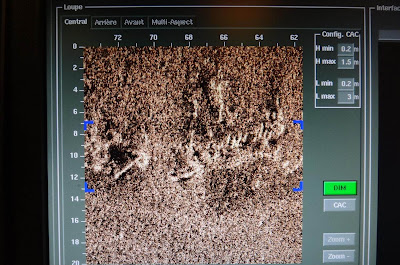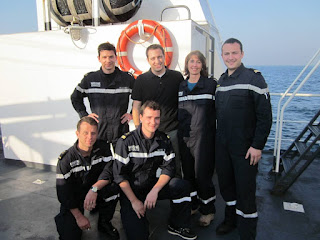Sometimes there’s a delayed reaction with media articles. I was not very proactive in promoting the recent expedition, but I’m glad someone else was. The Naval Meteorology and Oceanography Command produced a nice article that appeared on the Navy News web site today. We’ll see if it inspires any additional interest from other media folks.
Ensign Vincent Chamberlain, leader of the NOMWC crew, told Rear Adm. Jonathan White, commander of the Naval Meteorology and Oceanography Command (NMOC), in a July 9 briefing that the crew spent May 27 through June 7 surveying the North Sea site of the wreck, part of the multinational, multi-organization effort.
“This was a great opportunity for us to test some new equipment, to train on the equipment in a different environment, to work with the French navy and to help find a historically significant artifact to our navy and our nation,” White said.
Bonhomme Richard, captained by John Paul Jones, sank in the North Sea in 1779, following the Battle of Flamborough Head during the American Revolution. Since 2006, the Ocean Technology Foundation (OTF) and its partners have conducted expeditions in the North Sea to try to find the remains of the ship. Naval Oceanography assisted in the last three expeditions in 2010, 2011 and 2012. OTF is an undersea research and education service organization whose activities range from supporting its own projects to developing deep water technologies and research programs. White’s command directs the operations of naval oceanography. This year’s search was a joint operation with the French navy.
“NMOC allowed for increased productivity in this year’s mission with their unmanned underwater vehicle (UUV) and expert team of technicians,” said Melissa Ryan, OTF chief scientist and project manager. “The UUV provided detailed, high resolution imagery of 48 targets, and allowed us to determine whether these targets were worthy of further investigation.”
The NOMWC group, which operated off the French dive ship, Styx, surveyed with a Remus 100 Unmanned Underwater Vehicle. Remus uses side-scan sonar to image the bottom. Those images reveal objects that could be a remnant of the ship. NOMWC uses Remus the same way to search for mines.
“Our team gained a lot of experience conducting operations from a French dive ship and utilizing deep water transponders for UUV navigation,” said Chamberlain.
NOMWC shared the data with OTF for analysis.
For more information, visit www.navy.mil, www.facebook.com/usnavy, or www.twitter.com/usnavy.
For more news from Naval Meteorology and Oceanography Command, visit www.navy.mil/local/cnmoc/.









